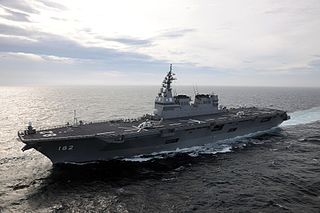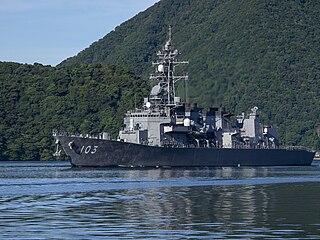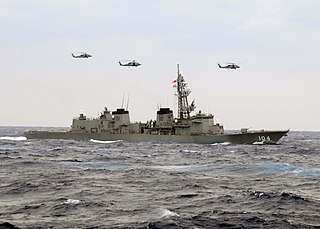
The Murasame-class destroyer is a class of destroyers, serving with the Japan Maritime Self-Defense Force (JMSDF). This is the first class of the second-generation general-purpose destroyers of the JMSDF.

The Takanami-class destroyer is a class of destroyer serving with the Japan Maritime Self-Defense Force (JMSDF). This warship is the slightly modified class of second-generation, general-purpose destroyers of the JMSDF.

The Akizuki class of destroyers of the Japan Maritime Self-Defense Force is intended to escort the Hyūga-class and Izumo-class helicopter destroyers, and safeguard the other Aegis-capable warships such as the Kongō class and Atago class. The destroyer provides defense against surface, airborne and undersea threats. The class was initially designated as "19DD", referring to a date on the Japanese calendar, specifically the 19th fiscal year of the Heisei period (2007).

JS Chōkai (DDG-176) is a Kongō-class guided missile destroyer in the Japan Maritime Self-Defense Force (JMSDF). Chōkai was named after Mount Chōkai. She was laid down by IHI Corporation in Tokyo on 29 May 1995 and was launched on 27 August 1996. Commissioning happened on March 20, 1998.

JS Takanami (DD-110) (たかなみ) is the lead vessel of the Takanami-class destroyers of the Japan Maritime Self-Defense Force (JMSDF).

JS Ōnami (DD-111) is the second vessel of the Takanami-class destroyers of the Japan Maritime Self-Defense Force (JMSDF).

JS Makinami (まきなみ) is the third vessel of the Takanami-class destroyers of the Japan Maritime Self-Defense Force (JMSDF).

JS Sazanami (さざなみ) is the fourth vessel of the Takanami-class destroyers of the Japan Maritime Self-Defense Force (JMSDF).

JS Ise (DDH-182) is a Hyūga-class helicopter destroyer of the Japan Maritime Self-Defense Force (JMSDF). It is the second ship to be named Ise, the first being the Imperial Japanese Navy World War II-era battleship Ise.

JS Suzunami (すずなみ) is the fifth vessel of the Takanami-class destroyers of the Japan Maritime Self-Defense Force (JMSDF).

JS Murasame (むらさめ) is the lead vessel of the Murasame-class destroyers of the Japan Maritime Self-Defense Force (JMSDF).

JS Suzutsuki (DD-117) is the third ship of Akizuki-class destroyers, operated by the Japan Maritime Self-Defense Force. She was commissioned on 12 March 2014.
JS Harusame (DD-102) is the second ship of Murasame-class destroyers. She was commissioned on 24 March 1997.

JS Yūdachi (DD-103) is the third ship of Murasame-class destroyers. She was commissioned on 4 March 1999.

JS Ariake (DD-109) (ありあけ) is the ninth ship of Murasame-class destroyers. She was commissioned on 6 March 2002.

JS Ikazuchi (DD-107) is the seventh ship of the Murasame-class destroyers in service with the Japan Maritime Self-Defense Force. She was commissioned on 14 March 2001.

JS Akebono (DD-108) is the eighth ship of Murasame-class destroyers. She was commissioned on 19 March 2002.

JS Kirisame (DD-104) is the fourth ship of Murasame-class destroyers of the Japan Maritime Self-Defense Force (JMSDF). She was commissioned on 18 March 1999.

JS Samidare (DD-106) is the sixth Murasame-class destroyer of the Japan Maritime Self-Defense Force (JMSDF). She was commissioned on 21 March 2000.

JS Umigiri (DD-158) is an Asagiri-class destroyer of the Japan Maritime Self-Defense Force.



























